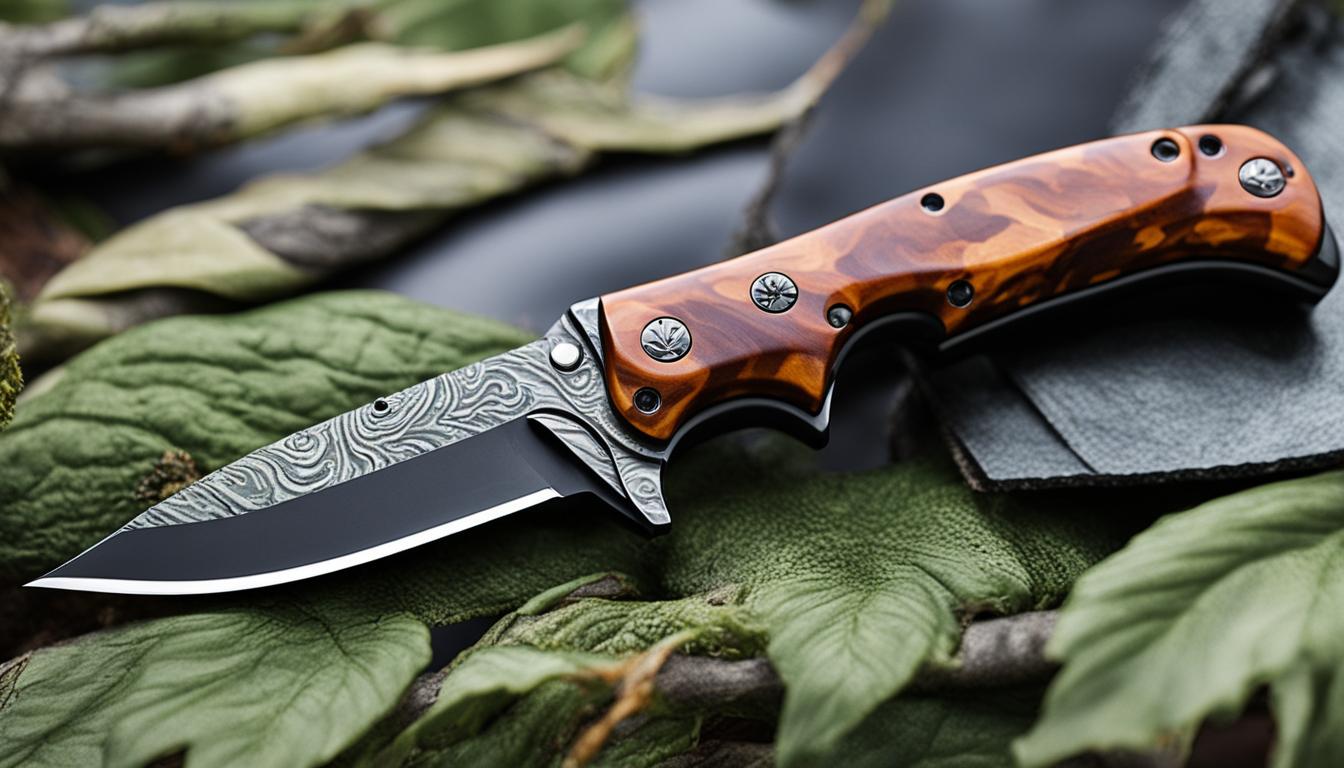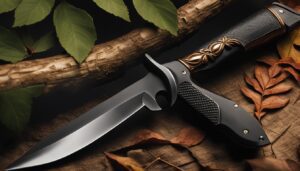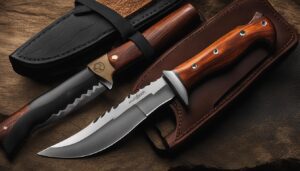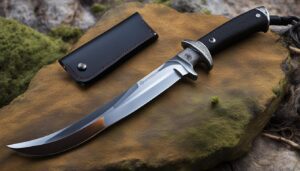Knives are a crucial tool for hunters, and choosing the right camouflage hunting knife is essential for a successful hunting adventure. When selecting a hunting knife, there are various factors to consider, such as the blade style, fixed blade vs. folding knife, and the quality of craftsmanship. Investing in a high-quality hunting knife is important because it ensures durability, safety, and optimal performance in the field.
Key Takeaways:
- Choosing the right camouflage hunting knife is crucial for a successful hunting adventure.
- Consider factors such as blade style, fixed blade vs. folding knife, and quality craftsmanship.
- Invest in a high-quality hunting knife for durability, safety, and optimal performance.
- Blade styles like drop point, boning blade, and clip point offer versatility for different hunting tasks.
- Blade length, materials, and handle materials are important factors to consider when selecting a hunting knife.
Blade Styles for Hunting Knives
When it comes to choosing a camouflage hunting knife, one of the key considerations is the blade style. Different blade styles offer unique advantages and are suitable for various hunting tasks. Let’s explore some of the most popular blade styles for camouflage hunting knives:
Drop Point
The drop point blade style is widely used in hunting knives due to its versatility and strength. The blade has a convex curve, allowing for easy slicing and skinning. The robust tip of the drop point blade makes it ideal for heavy-duty tasks and offers excellent control during precision cutting.
Boning Blade
If you’re looking for a hunting knife to assist with meat separation during field dressing, a boning blade is an excellent choice. This blade style features a thin, narrow, and flexible design, allowing hunters to maneuver around bones and joints easily. The boning blade ensures clean and precise cuts, minimizing wastage during dressing.
Clip Point
Clip point blades are commonly found on folding knives and offer a versatile option for hunting enthusiasts. The distinctive characteristic of a clip point blade is the concave cut-out near the spine, which creates a sharper point. This blade style combines strength and versatility, making it suitable for a wide range of hunting tasks.
Whether you prefer the strength and versatility of a drop point blade, the precision of a boning blade, or the versatility of a clip point blade, choosing the right blade style for your camouflage hunting knife is crucial. Consider the specific hunting tasks you’ll be undertaking to make an informed decision that best suits your needs.
Table: Blade Style Comparison
| Blade Style | Advantages | Best Use |
|---|---|---|
| Drop Point | Versatile, strong, excellent control | Skinning, slicing, heavy-duty tasks |
| Boning Blade | Precise, clean cuts, minimal wastage | Meat separation during field dressing |
| Clip Point | Strong, versatile, sharper point | Wide range of hunting tasks |
Factors to Consider in Choosing a Hunting Knife
When embarking on a hunting adventure, selecting the right camouflage hunting knife is crucial. There are several key factors to consider that will ensure you choose a knife that suits your needs and preferences.
Blade Length
The blade length of a hunting knife is an important consideration. A four-inch blade is a popular choice for field knives as it offers versatility for a range of tasks. A longer blade may be suitable for larger game, while a shorter blade is ideal for more intricate work. Consider the type of hunting you will be doing and choose a blade length that will best serve your needs.
Fixed Blade vs. Folding Knife
Another factor to consider is whether you prefer a fixed blade or a folding knife. A fixed blade knife offers enhanced durability and strength, making it reliable for heavy-duty tasks. Fixed blades are also easier to clean and maintain. On the other hand, folding knives are compact and convenient to carry, making them a popular choice for those who prioritize portability. Consider your personal preference and the specific tasks you will be undertaking in order to make the best choice.
Quality Craftsmanship
Investing in a high-quality hunting knife is essential to ensure both durability and safety. Look for a knife that is crafted with precision and attention to detail. Quality materials, such as stainless steel, contribute to the overall performance and longevity of the knife. By choosing a well-crafted hunting knife, you can trust that it will withstand the rigors of the hunt and serve you well for years to come.
When selecting a hunting knife, it is important to carefully consider the blade length, the choice between a fixed blade or folding knife, and the quality of craftsmanship. By evaluating these factors, you can choose a knife that aligns with your specific hunting needs and ensures a successful and enjoyable experience in the field.
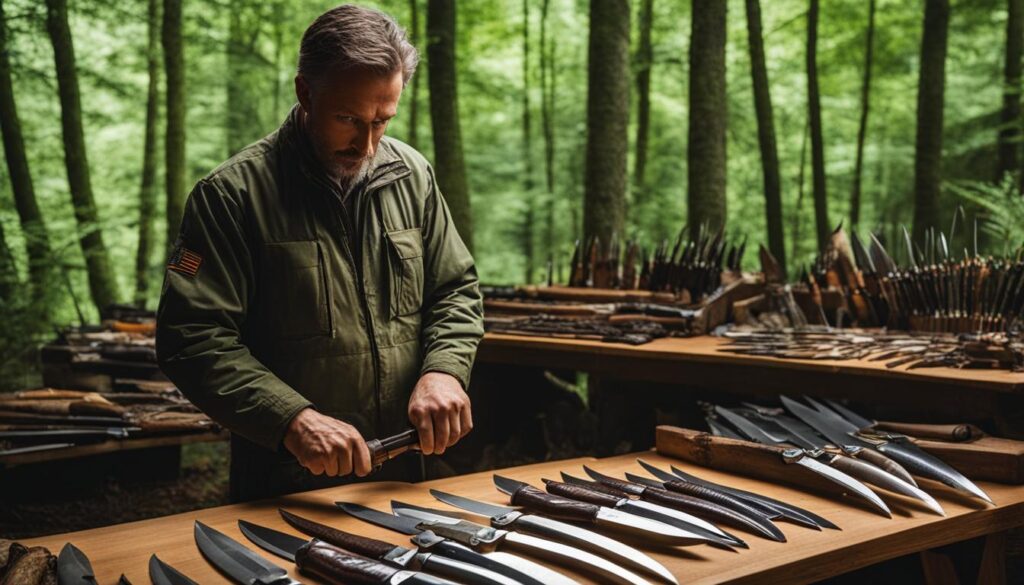
Selecting the Right Materials for Your Hunting Knife
When choosing a camouflage hunting knife, it’s crucial to consider the materials used. The blade material and handle material play a significant role in the knife’s performance, durability, and overall quality. By selecting the right materials, you can ensure that your hunting knife meets your needs and withstands the demands of the wilderness.
Blade Materials
The blade material is a key factor in determining the sharpness, strength, and corrosion resistance of your hunting knife. Two popular options for blade materials are stainless steel and high carbon stainless steel. Stainless steel blades offer excellent corrosion resistance and ease of maintenance. On the other hand, high carbon stainless steel blades provide superior sharpness and edge retention, making them ideal for heavy-duty tasks. Consider your hunting environment and maintenance preferences when selecting the blade material for your camouflage hunting knife.
Handle Materials
The handle material of your hunting knife is essential for providing a secure grip and withstanding moisture and other environmental factors. Modern materials like plastic are lightweight, durable, and easy to maintain. They offer a reliable grip even in wet conditions. However, if you prefer a more traditional and elegant touch, handle materials like bone and antler can add a unique aesthetic appeal to your hunting knife. Ultimately, the handle material should be chosen based on personal preference, functionality, and the specific demands of your hunting adventures.
| Blade Material | Advantages |
|---|---|
| Stainless Steel | Excellent corrosion resistance |
| High Carbon Stainless Steel | Superior sharpness and edge retention |
| Handle Material | Advantages |
|---|---|
| Plastic | Lightweight, durable, and easy to maintain |
| Bone and Antler | Unique aesthetic appeal |
Choosing the right materials for your camouflage hunting knife ensures that you have a reliable tool by your side during your hunting adventures. Whether you prioritize corrosion resistance, sharpness, grip, or aesthetic appeal, there are materials available to suit your preferences. Remember to consider the blade material and handle material carefully to make an informed decision that meets your needs both functionally and visually.
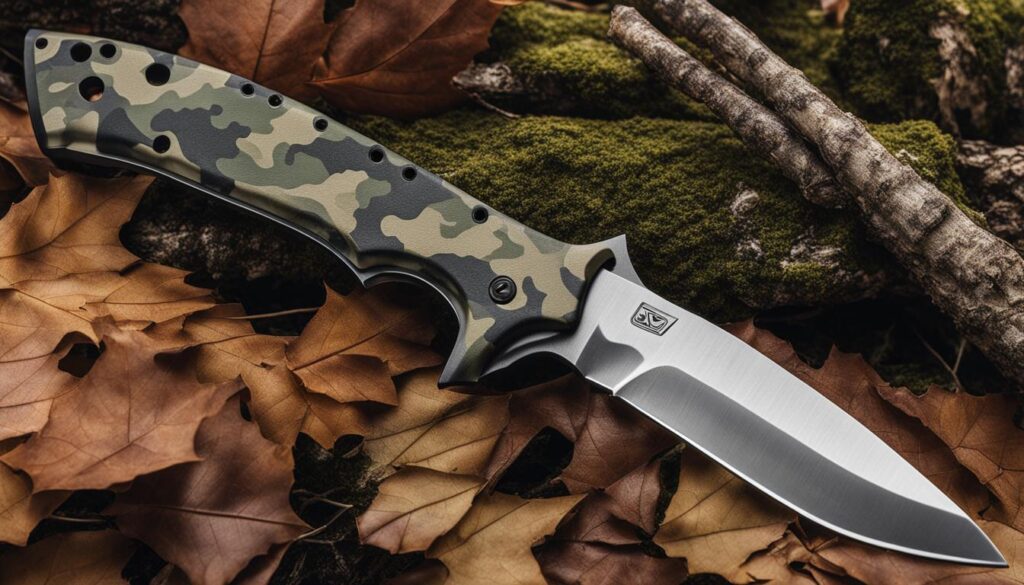

Conclusion
After considering the various factors involved in choosing a hunting knife, it becomes clear that selecting the right camouflage hunting knife is crucial for a successful hunting adventure. By carefully examining the blade style, blade length, craftsmanship, and materials, hunters can find a knife that perfectly suits their needs and preferences.
Investing in a high-quality hunting knife ensures not only durability but also safety and optimal performance in the field. A well-crafted hunting knife made with top-notch materials will withstand the toughest tasks and provide a reliable tool for years to come. Whether you’re an experienced hunter or just starting out, having the right camouflage hunting knife is an essential part of your hunting gear.
With the right camouflage hunting knife in hand, you can confidently tackle any hunting task that comes your way. From field dressing game to skinning and everything in between, a well-chosen hunting knife will make the job easier and more efficient. So, take the time to research and select the perfect camouflage hunting knife for your hunting adventures, and enjoy the great outdoors with the confidence of being well-equipped.
FAQ
What are the most commonly used blade styles for camouflage hunting knives?
The most commonly used blade styles for camouflage hunting knives are the drop point, boning blade, and clip point.
What factors should I consider when choosing a camouflage hunting knife?
When choosing a camouflage hunting knife, it is important to consider the blade length, the decision between a fixed blade and a folding knife, and the quality of craftsmanship.
What materials are important to consider in a hunting knife?
The blade material and handle material are both important considerations in a hunting knife. Blade materials like stainless steel and high carbon stainless steel offer different advantages, while handle materials should provide a secure grip and be resistant to moisture.
Why is it important to invest in a high-quality hunting knife?
Investing in a high-quality hunting knife ensures durability, safety, and optimal performance in the field. A well-made knife will last longer and provide a reliable tool for your hunting adventures.
